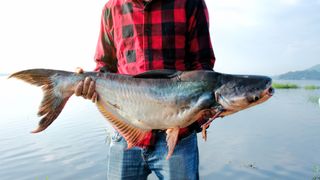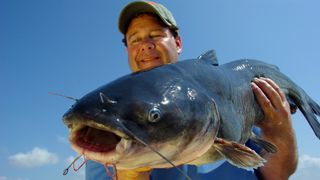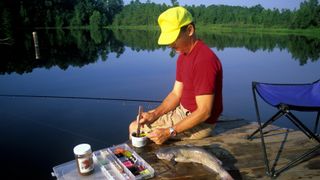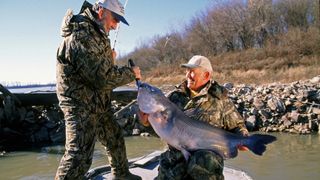How to catch catfish: know everything about species, tackle, bait and timing
We all love to catch catfish. Haul in more of this popular, lively fish with these essential tips and all the knowledge you need to be a catfishing connoisseur

Everyone loves them so learning how to catch catfish is a vital skill for anyone who picks up a rod. Part of the reason these whiskery denizens of the deep are so fondly thought of is that any angler, from young to old, with any level of skill, can catch catfish and have a lot of fun trying. These strong, spirited fish don't go down without a fight which makes them exciting to haul in. Catfish are plentiful, widespread, grow to an impressive size, and are delicious to eat too.
To catch catfish, anglers tend to fall into two types of approaches. There are those who want to catch smaller catfishes to eat, and those who target large fish for sport and great photographs of their trophy catch. Kit yourself out with the best catfish rods and the best fishing line and you can catch either. It doesn't matter which category of catfish angler you're in, these tips on how to catch catfish will help you reel more in of any size and give you all the knowledge you need to become a seasoned catfish angler.

Types of catfish to go for
The big three North American catfish species are the channel catfish, blue and flathead.
Channels range the most widely. Transplants expanded their territory from native waters between the Rocky and Appalachian mountains to every state but Alaska. They are important sportfish in 32 states. One to ten pounders are common.
At 140lb-plus, the blue cat is North America’s largest. This species ranges through 29 states, from South Dakota to Texas and Washington to Florida. In many Southern and Midwestern waters, ten to 50-pounders are common, and 60 to 100-pounders occasionally surface.
Flathead catfish are native to the Mississippi, Mobile and Rio Grande river drainages, plus the Great Lakes region, but stockings expanded their range from border to border with 30 to 50-pounders common in many waters. Bigger fish are rare but sometimes caught in blue-ribbon lakes and rivers.

Best baits to catch catfish
When you're thinking about how to choose fishing bait, small catfish aren’t finicky about food. Good baits include night crawlers, minnows and crayfish, which you can buy at bait shops or collect yourself, plus wild baitfish like shad, skipjack herring and sunfish, big grasshoppers, frogs, catalpa worms (a type of caterpillar) and leeches.
Advnture Newsletter
All the latest inspiration, tips and guides to help you plan your next Advnture!
Commercial and homemade 'stinkbaits' also entice small catfish and are some of the best catfish bait you can buy. Discount stores often carry these, along with specialty items you might need to fish with them, including sponge hooks, spring-wound dough-bait treble hooks and ribbed, soft-plastic lures used for fishing dip baits.
Catfish exceeding 10lb primarily eat fish, so when targeting trophies, use fish baits to catch them. Oily baitfish such as shad, herring and suckers are tops. Others to try include carp, chubs, goldeyes and sunfish. Always use live fish for big flatheads; they rarely eat anything else. Jumbo blues and channels will eat fish alive or dead, including cut-baits prepared by slicing fresh baitfish into chunks or fillets.
Having trouble obtaining bait? Head to the supermarket. Fresh chicken liver is one of the best catfish baits. For trophy blue cats, try Hormel Spam. Jumbo channel cats love cheap hot dogs and will even gobble up shrimp, squid, cheese, grapes and even Ivory soap!
Catfish sometimes feed at mid-depths or on the surface, but they are largely bottom feeders and you’ll catch more with bait on or near the substrate. Let the bait sit for several minutes before moving it. Cats smell their treats, then track them down.

Where and when to fish for catfish
Catfish inhabit everything from small creeks and ponds to big rivers and reservoirs. Check online or contact your state fisheries department via their website to learn the location of prime catfish fishing waters.
Search for active feeders along drop-offs, near riprap, around points and in flooded timber. Sometimes they’re beneath undercut banks, in quiet water behind midstream rocks, a deeper pool washed in a stream bend or where a fallen tree creates rotating water.
Some big cats, especially flatheads, prowl more at night so learn how to go night fishing. But most catfish feed actively day or night. Go fishing whenever you can.
Catfishing is not just a summertime sport, though many anglers think that. You can fish year-round and expect to do well. Trophy blue cats often are caught on deep ledges in winter. Normally sedentary flatheads roam and feed ravenously during high water in spring, and again in autumn. Channel cats bite spring, summer, fall and winter. Ice fishermen often catch them.
Fish every chance you get, regardless of the season. That’s the best way to catch lots of these amazing gamefish!
Keith Sutton’s passion for outdoor adventure has taken him to blue-ribbon fishing destinations on four continents, making him a true expert in his field. Along the way, he’s become one of America’s best-known outdoor writers and photographers and earned the nickname “Catfish” because of his passion for chasing those whiskered warriors. He has written 13 books, including Hardcore Catfishing, Fishing Arkansas, The Crappie Fishing Handbook and Out There Fishing, and in 2012, he was enshrined in the National Fresh Water Fishing Hall of Fame as a Legendary Communicator.
Most Popular

